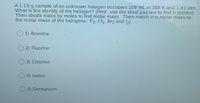
Chemistry
10th Edition
ISBN: 9781305957404
Author: Steven S. Zumdahl, Susan A. Zumdahl, Donald J. DeCoste
Publisher: Cengage Learning
expand_more
expand_more
format_list_bulleted
Concept explainers
Question
What is the identity of the halogen? Then divide mass by miles to find molar mass, then match this molar mass to the molar mass of the halogens: F2, CI2, Br2 and I2.

Transcribed Image Text:A 1.19 g sample of an unknown halogen occupies 109 mL at 398 K and 1.41 atm.
What is the identity of the halogen? (Hint: use the ideal gas law to findn (moles).
Then divide mass by moles to find molar mass. Then match this molar mass to
the molar mass of the halogens: F2, Cl2, Br2 and 12)
1) Bromine
O 2) Fluorine
3) Chlorine
4) lodine
5) Germanium
Expert Solution
This question has been solved!
Explore an expertly crafted, step-by-step solution for a thorough understanding of key concepts.
This is a popular solution
Trending nowThis is a popular solution!
Step by stepSolved in 2 steps

Knowledge Booster
Learn more about
Need a deep-dive on the concept behind this application? Look no further. Learn more about this topic, chemistry and related others by exploring similar questions and additional content below.Similar questions
- Calculate the amount of anions (in moles) in 8.6 g of magnesium perchlorate. Express your answer with two significant figures.arrow_forwardA sample of aluminum contains 2.91 x 1022 atoms of aluminum. What is the mass of this sample? [Avogadro’s number: 6.022 x 1023; Molar mass: Al, 26.98 g/mol]arrow_forwardA 3.41 g sample of a metallic element, M, reacts completely with 0.0158 mol of a gas, X2, to form 4.52 g of MX. What are the identities of M and X?arrow_forward
- 4) Ozone, O3, is a product in automobile exhaust by the equation NO2(g) + O2(g) → NO(g) + O3(g). What mass of ozone is predicted to form from the reaction of 2.0 g NO2 in a car's exhaust and excess oxygen? A) 1.8 g O3 B) 1.1 g O3 C) 2.1 g O3arrow_forwardA 2.1880 g sample of a hydrate of Cu(NO3)2 was heated to drive off all of the water of hydration. The remaining solid weighed 1.6986 g. If Cu(NO3)2 X H₂O represents the formula of the hydrate, then what is the value of x? Note: The notation Cu(NO3)2 X H₂O indicates that there are x moles of H₂O for every mole of Cu(NO3)2 in the solid hydrate. Molar masses (in g mol¯¹): H, 1.008 Mg, 24.31 Ni, 58.69 N, 14.01 S, 32.07 Cu, 63.55 O, 16.00 Mn, 54.94 Hg, 200.6arrow_forwardWhat is the mass in grams of 5.0 x 10 6 molecules of formaldehyde, CH2O?arrow_forward
- What is the mass in grams of 1.44 × 10²⁵ molecules of I₂?arrow_forwardthe formula for disulfiram decafluoride is S2F10 A.How many molecules are in 1.35 grams of disulfur decafluoride? B.what is the mass in grams of 1.55 x 10^22 molecules of disulfur decafluoride?arrow_forwardA scientist is trying to discover information about an unknown metal in a compound. The formula for the compound is believed to be XBr, where X is the unknown metal. The scientist determined that a 4.741 g sample of this compound contains 4.812 x 10-2 mol Br. Calculate the atomic mass of the unknown metal, X. atomic mass = amu What is the identity of the metal? Provide the name or symbol of the element. metal:arrow_forward
- A student is given a mixture containing two nitrate compounds. The mixture includesNaNO3 and Ca(NO3)2. The mixture is 73.31% NO3 by mass. What is the mass percent of NaNO3 in the mixture?arrow_forwardA scientist is trying to discover information about an unknown metal in a compound. The formula for the compound is believed to be XBr, where X is the unknown metal. The scientist determined that a 4.720 g sample of this compound contains 4.745 x 10-2 mol Br. Calculate the atomic mass of the unknown metal, X. atomic mass = amu What is the identity of the metal? Provide the name or symbol of the element. metal:arrow_forward10. What is the mass of 3.45 moles of aluminum sulfate [Al2(SO4)3]?arrow_forward
arrow_back_ios
SEE MORE QUESTIONS
arrow_forward_ios
Recommended textbooks for you
 ChemistryChemistryISBN:9781305957404Author:Steven S. Zumdahl, Susan A. Zumdahl, Donald J. DeCostePublisher:Cengage Learning
ChemistryChemistryISBN:9781305957404Author:Steven S. Zumdahl, Susan A. Zumdahl, Donald J. DeCostePublisher:Cengage Learning ChemistryChemistryISBN:9781259911156Author:Raymond Chang Dr., Jason Overby ProfessorPublisher:McGraw-Hill Education
ChemistryChemistryISBN:9781259911156Author:Raymond Chang Dr., Jason Overby ProfessorPublisher:McGraw-Hill Education Principles of Instrumental AnalysisChemistryISBN:9781305577213Author:Douglas A. Skoog, F. James Holler, Stanley R. CrouchPublisher:Cengage Learning
Principles of Instrumental AnalysisChemistryISBN:9781305577213Author:Douglas A. Skoog, F. James Holler, Stanley R. CrouchPublisher:Cengage Learning Organic ChemistryChemistryISBN:9780078021558Author:Janice Gorzynski Smith Dr.Publisher:McGraw-Hill Education
Organic ChemistryChemistryISBN:9780078021558Author:Janice Gorzynski Smith Dr.Publisher:McGraw-Hill Education Chemistry: Principles and ReactionsChemistryISBN:9781305079373Author:William L. Masterton, Cecile N. HurleyPublisher:Cengage Learning
Chemistry: Principles and ReactionsChemistryISBN:9781305079373Author:William L. Masterton, Cecile N. HurleyPublisher:Cengage Learning Elementary Principles of Chemical Processes, Bind...ChemistryISBN:9781118431221Author:Richard M. Felder, Ronald W. Rousseau, Lisa G. BullardPublisher:WILEY
Elementary Principles of Chemical Processes, Bind...ChemistryISBN:9781118431221Author:Richard M. Felder, Ronald W. Rousseau, Lisa G. BullardPublisher:WILEY

Chemistry
Chemistry
ISBN:9781305957404
Author:Steven S. Zumdahl, Susan A. Zumdahl, Donald J. DeCoste
Publisher:Cengage Learning

Chemistry
Chemistry
ISBN:9781259911156
Author:Raymond Chang Dr., Jason Overby Professor
Publisher:McGraw-Hill Education

Principles of Instrumental Analysis
Chemistry
ISBN:9781305577213
Author:Douglas A. Skoog, F. James Holler, Stanley R. Crouch
Publisher:Cengage Learning

Organic Chemistry
Chemistry
ISBN:9780078021558
Author:Janice Gorzynski Smith Dr.
Publisher:McGraw-Hill Education

Chemistry: Principles and Reactions
Chemistry
ISBN:9781305079373
Author:William L. Masterton, Cecile N. Hurley
Publisher:Cengage Learning

Elementary Principles of Chemical Processes, Bind...
Chemistry
ISBN:9781118431221
Author:Richard M. Felder, Ronald W. Rousseau, Lisa G. Bullard
Publisher:WILEY